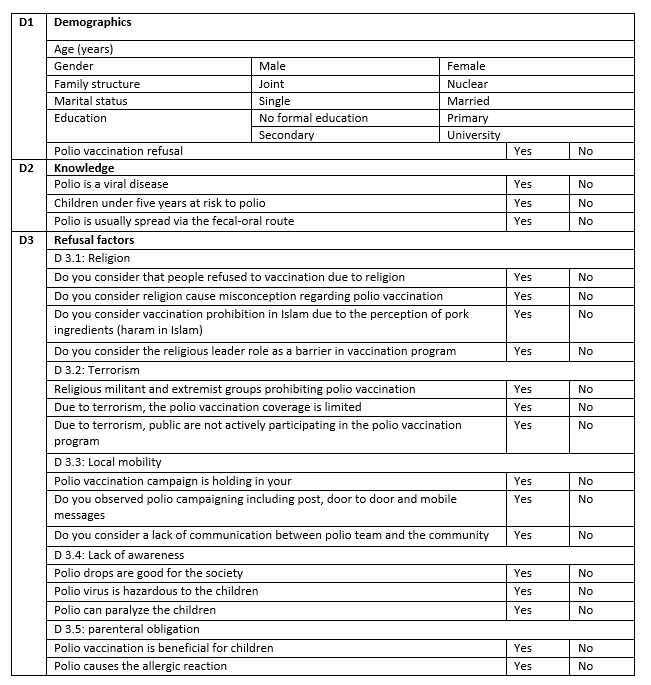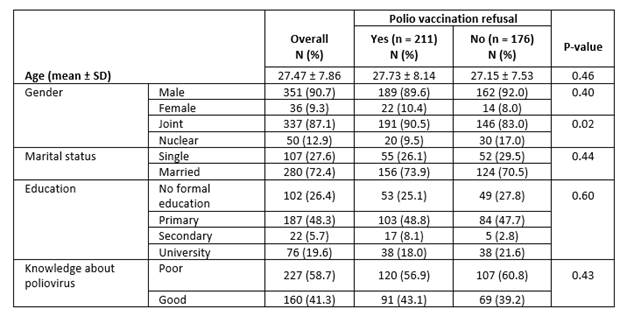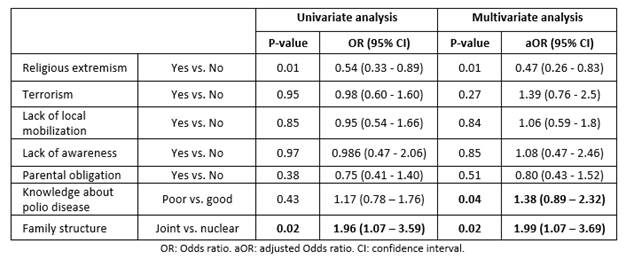Introduction
Poliomyelitis caused by poliovirus is a contagious and life-threatening acute paralytic disease that causes severe neuron damage, which leads to paralysis.1,2 Poliovirus is classified as an enterovirus within the Picornaviridae family. It has three serotypes (1, 2, and 3) that can cause paralytic disease.3 Poliovirus is usually transmitted via the fecal-oral route, thus, areas with poor sanitation are at high risk. In addition, direct contact with an infected person may cause polio disease.
The Global Polio Eradication Initiative (GPEI) founded in 1988, played a significant role in the eradication of polio globally. Remarkable strides have been made in combating wild polio virus (WPV) serotypes; specifically, types 2 and 3 have been successfully eradicated, leading to a staggering reduction of over 99.9% in global WPV cases.4 However, despite these achievements, the challenge persists in Afghanistan and Pakistan, the only remaining countries where indigenous transmission of WPV type 1 (WPV1) has not been halted.5,6,7 In 2019, 147 cases were reported, followed by 84 cases in 2020 and 1 case in 2021. After this decline in cases, in 2022, 20 WPV1 cases were reported.5
Despite the continuous effort and strategies built up in eradicating polio, Pakistan still is counted among the few countries that have a high ratio of polio cases in contrast to other countries of the world. 8). It has been reported that most polio cases are observed and recorded in the region of Federal Administered Tribal Areas (FATA), which are part of the Northern side of Pakistan. This area has been affected by the war on terror for more than 2 decades. It has been observed that polio vaccination has been banned several occasions by religious extremists in this area.9 As a result, most children remain unvaccinated and become prone to polioviruses.5 In addition, there is a lack of education facilities and access to education. Therefore, it is assumed that lack of awareness, terrorism and inaccessibility to polio vaccination may influence the refusal of polio vaccination. Therefore, the current study was aimed to assess factors that play a role in polio vaccination refusal.
Materials and Methods
A descriptive cross-sectional approach was used for the current study and was conducted between January 2023 to July 2023. The study setting was District North Waziristan located in the southern area of Khyber Pakhtunkhwa, Pakistan. This is the border-side area located near the Pak-Afghan border. The total population of this area is 693,332. 10) The study participants were general population residents of District North Waziristan. The inclusion criteria for this study were the parents, whether they vaccinated their children or not, and residents of the district north Waziristan.
Sample size and sampling
The Raosoft sample size calculator was used for sample calculation. The calculated sample size was 384, and a 5% dropout rate was added, thus, the final sample size was 403. Participants in the current study were selected using a simple random sampling technique.
Study instrument and data collection
The study questionnaire was designed based on the previously published literature.11,12 Two experts from the same background validated the initial draft, with their suggested changes integrated into the study questionnaire before the pilot study. The study was piloted on 10% of the total sample size (n = 36) to assess the internal consistency of the study instrument. A crone-Bach Alpha value of 0.71 was obtained, which shows a valid internal consistency. The participants of the pilot study were excluded from the final analysis.
The data were obtained using Google Forms (Google, Inc, USA). The Urdu translation was incorporated into the questionnaire and was carried out by experts in the field using forward and backward translation methods. The data was collected using a local trained data collector.
The questionnaire was composed of three domains. The first domain was related to the demographic data of the participants, including age, gender, family structure, marital status, and education. The family structure (joint: an extended family, typically consisting of three or more generations and their spouses, living together as a single household; nuclear: a couple and their dependent children, regarded as a basic social unit) was incorporated as it has a role in child care.13 The second domain was related to knowledge about the nature of poliovirus, its transmission and risk factors. The third domain was related to the refusal factors, including religion, terrorism, lack of local mobility, lack of awareness about polio and polio vaccination and parenteral obligation. The responses were collected on a yes and no basis. The correct response was assigned 1 point, while the incorrect was awarded with 0-point. Regarding knowledge, we used a cut-off point of 50% (<50% - poor, >50% - good). The detail of the questionnaire is given in Table 1.
Ethic
The ethical approval was taken from the Ethical Committee of Kohat University of Science and Technology, Kohat, Pakistan. Participants were treated as per the Declaration of Helsinki. The participant's confidentiality was maintained throughout the study. Informed consent was obtained from each participant.
Statistical analysis
The data were analyzed using Statistical package for social sciences (SPSS v25). The categorical data were presented as frequency and percentages, while the continuous data were tabulated as mean and standard deviation. The parametric test, Chi-square test, was applied based on the normality test, as the data showed normal distribution. To identify the predictors of the polio refusal, logistic regression analysis was used. The two-tailed p-value was considered significant at ≤0.05.
Results
A total of 387 respondents completed the survey (response rate: 96.02%), amongst which most of the respondents were male (90.7%), living in a joint family (87.1%) and had primary education (48.3%). Most of the respondents showed poor knowledge regarding polio disease (58.7%), as shown in Table 2.
Regarding the polio vaccination refusal, the respondents reported that lack of awareness, terrorism and religious extremism have a role in vaccination refusal, as shown in Figure 1 and Figure 2. The regression analysis showed that religious extremism and the joint family system are a significant predictor of the vaccination refusal. In the multivariate analysis, poor knowledge about polio virus was also a significant predictor of vaccine refusal. The details can be seen in Table 3.
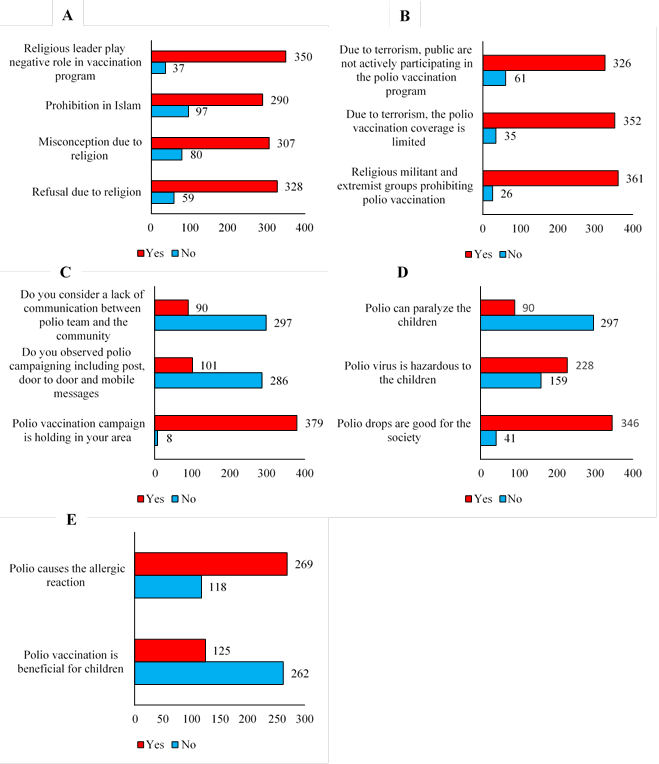
Fig. 1 Parenteral view regarding refusal factors including religion (A), terrorism (B), local mobility (C), lack of awareness (D), parenteral obligations (E).
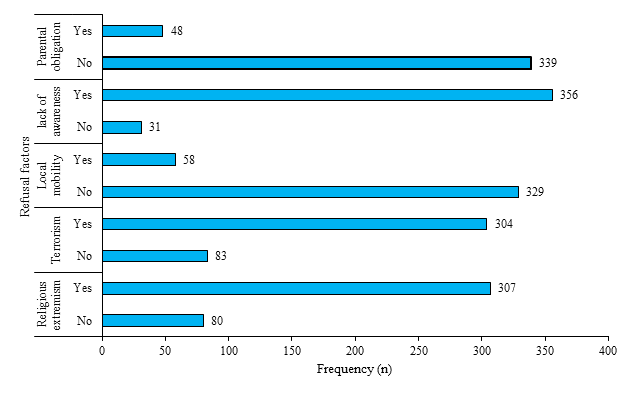
Fig. 2 Role of religious extremism, terrorism, lack of local mobility, lack of awareness, and parental obligation in polio vaccine refusal.
Discussion
The current study aimed to assess the factors that play a role in polio vaccination refusal in a conflict area of Pakistan. Nearly half of the sample population (45.5%) reported refusal to polio vaccination. The regression analysis showed that religious extremism, poor knowledge regarding the disease and joint family structure play a significant role in polio vaccine refusal. The observation that a considerable proportion of the respondents showed refusal to polio vaccination can lead to the re-emergence of polio, a highly infectious and potentially deadly disease. When a significant portion of the population refuses vaccination, the disease can spread and cause outbreaks; this not only puts unvaccinated individuals at risk, but also poses a threat to the overall public health.14,15 Additionally, the refusal of polio vaccination can hinder global efforts to eradicate the disease, as it relies on high vaccination coverage to prevent transmission. 16) Therefore, the refusal of polio vaccination can have serious consequences for both individual and public health.
There is a complex interplay between religious extremism and polio vaccination refusal. Religious extremism and terrorism have been identified as significant factors contributing to polio vaccination refusal in Pakistan. Misconceptions and religious beliefs play a role in shaping the attitudes of parents and caretakers toward polio vaccines. These misconceptions include the belief that vaccines are part of American and Jewish conspiracies, that vaccines are un-Islamic and aimed at sterilizing young Muslims, and that vaccines contain haram (forbidden) ingredients. Extremist groups have also spread propaganda and threatened people to discourage vaccination efforts.17,18,19 Similar results were found in the current study. Extremist groups have targeted and even assassinated vaccination officials, hindering vaccination campaigns and allowing the transmission of wild poliovirus.17,20 The influence of religious leaders and the endorsement of polio vaccination by religious scholars are seen as potential solutions to address these misconceptions and increase acceptance of vaccines.
Misperceptions about the polio vaccine persist and play a significant role in vaccine refusal for both polio and routine immunization. The low confidence in frontline workers and vaccination campaigns, along with complex political and bureaucratic management, local resistance, and insecurity, have hindered vaccination efforts.21,22 To address these challenges, it is crucial to localize vaccination programs by considering the local environment, improving local ownership, and tailoring efforts to achieve polio eradication goals. The success of the polio program in Pakistan requires collaboration between politicians, community mobilizers, government, public health specialists, and education departments.
The current study has some limitations. Firstly, the data collected relied on self-reported measures through a questionnaire; therefore, recall bias cannot be ignored. Secondly, the cross-sectional design prevents causal relationships between variables, suggesting a need for longitudinal studies. Finally, the potential confounding factors, such as socioeconomic status, cultural beliefs, and access to healthcare services, were not comprehensively addressed, suggesting the need for future research incorporating a broader range of covariates.













